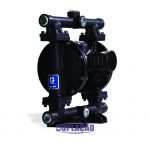A bomba sanitária Saniforce da Graco consegue realizar o bombeamento de 1.500 kg de pasta de tomate em um tempo recorde: 10 minutos! Esse produto é um dos mais utilizados ao redor do mundo, sendo aplicado na confecção de diversos tipos de receitas. No Brasil, a pasta de tomate é utilizada por praticamente todas as famílias, desde os molhos de tomate prontos temperados até o ketchup.
Graças a esse grande consumo, a pasta de tomate é fabricada por diversas indústrias no país. Contudo, a fabricação desse produto apresenta alguns desafios que são enfrentados pela indústria, como veremos a seguir:
High viscosity paste pumping
Most tomato pastes are made with the addition of a thickener, which can make handling and transfer difficult. This high viscosity ends up making it difficult to handle this material, especially when transferring the product from processing to packaging.
Performing this transfer manually would be impossible depending on the size of your storage drum. In addition to requiring a large amount of manpower, this manual processing demands a lot of time and effort on the part of the team. The dump system is also not a viable alternative, due to the possibility of during transport, favoring the proliferation of bacteria and other microorganisms.
Another big factor to consider is the safety of the industrial environment during the dumping process. Due to the size of the drums used, manual unloading favors the incidence of serious accidents among workers. For this reason, it is essential to have the necessary resources for a safe and efficient transfer, as is the case with Graco's pneumatic diaphragm pump.
The food industry uses two types of pump application in tomato paste processing:
Autonomous discharge pump: Positive displacement pumps are very suitable for the safe and hygienic handling of products with high viscosity. Due to the characteristics of tomato paste, progressive cavity and rotary lobe pumps may not be the best option.
Positive displacement pumps are able, thanks to their low shear, to transport these products without destroying their integrity. The structure of the pump ensures minimal or even zero contact with the product and the oil that is part of the pump.
These pumps also have flow handling ability, where the company can adjust according to its needs.
Pumps for unloading: in this case the pumps are used to transfer the tomato paste to another storage or processing location. The pumps manage to carry out this transfer avoiding exposure to contaminating agents and contamination by bacteria. Within the food industry, pneumatic piston pumps are widely used, as they can deliver a high output pressure, even with viscous fluids.
DIAPHRAGM PUMP SANIFORCE 1590 HS – GRACO










